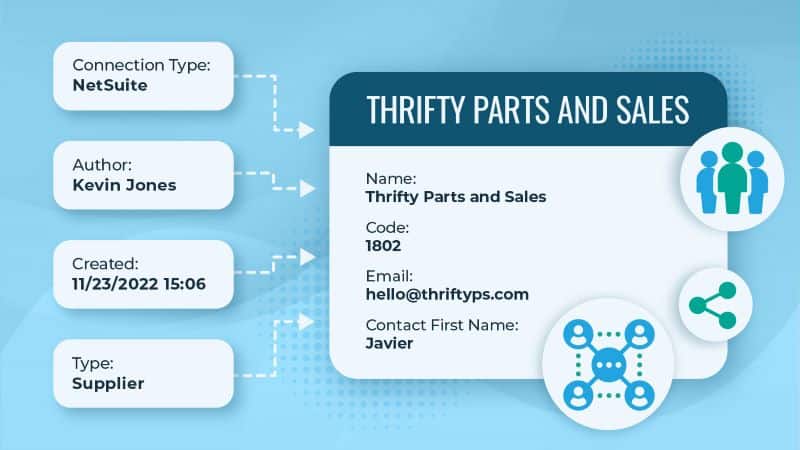Metadata Management vs. Master Data Management: Which Should You Do?


Table of Contents
- What Is Metadata Management?
- What Is Master Data Management (MDM)?
- Key Differences Between Metadata Management and Master Data Management
- Use Cases for Metadata Management
- Use Cases for Master Data Management
- Pros and Cons of Metadata Management
- Pros and Cons of Master Data Management
- Start Your Master Data Management Journey with Profisee Download Guide
Businesses generate and store a dizzying amount of data from a variety of different sources, intending to use that data to make better decisions. But merely having vast troves of data is not enough for organizations looking to become data-driven. To do that, organizations must practice some form of data management.
Metadata and master data are two types of data that are foundational components of an effective data management program. Though they sound similar, they serve different purposes, and understanding their unique contributions is vital for any organization aiming to use data strategically.
Let’s get started!
What Is Metadata Management?
Metadata management is the practice of organizing, structuring, formatting and storing metadata within an organization.
So what is metadata then? In simple terms, metadata is data about data. (That’s so meta!) It provides context and meaning to raw data, describing attributes such as creation date, category or type, usage and format. Because metadata describes the contents of master data (more on that in the next section), the two go hand-in-hand.
This is the heading
Example: Cookbooks and Metadata
It’s helpful to think about metadata as the different tags you might look up in an index to find something. For example, if you were trying to come up with an idea of what to make for dinner on a Tuesday, you might open your favorite cookbook to the index and look under headings like “weeknight” or “vegetarian” or “one-pot” to find an easy and healthy recipe. Those headings, or tags (weeknight, vegetarian, one-pot), are pieces of metadata in this example, while the different recipes would be master data records.
- Author
- Creation date and time
- File size
- Owner
- Access and permissions
- Type of data (customer, location, product)
- Source location
- Edit history
A Word on Active Metadata Management
In August 2021, Gartner decided to stop publishing its Magic Quadrant for Metadata Management, replacing it with a Market Guide for Active Metadata Management (paywall). This marked a significant shift in the market for metadata management solutions, as many companies were beginning to feel that legacy metadata management systems were merely “expensive shelfware,” according to Towards Data Science. In Gartner’s view, the problem with traditional (or passive) metadata management tools is that they can’t keep up with the increasing need for automation and cross-platform orchestration at enterprise companies. To help distinguish between metadata management tools that do and don’t meet these requirements, Gartner coined the term “active metadata management,” offering the following definition:Active metadata management is a set of capabilities that enables continuous access and processing of metadata that support ongoing analysis over a different spectrum of maturity, use cases and vendor solutions.
What Is Master Data Management (MDM)?
Borrowing from our explainer article on master data management, MDM is “…the technology, tools and processes that ensure master data is coordinated across the enterprise.” To understand MDM, we need to define master data. Master data is the core, non-transactional data used across an organization. Unlike , master data rarely changes, and it refers to real-world objects essential to business operations, like customers, products and locations. P.P.T. is a good acronym to help you remember what master data is:- People: Customers, employees, patients, healthcare providers, insurance brokers
- Places: Storefront and warehouse locations, buildings, floors, rooms
- Things: Products, recipes, medications
- Improving operational efficiency
- Growing revenue
- Decreasing risk
- Improving patient health outcomes
- Lowering procurement costs
- Maintaining regulatory compliance
- Enhancing customer experiences.
Key Differences Between Metadata Management and Master Data Management
While both metadata management and master data management are complementary components of a broader data governance program, they serve distinct purposes.| Metadata Management | Master Data Management | |
|---|---|---|
| Function | Focuses on providing context and insight into data records and is a requirement of good master data management. | Aims to ensure the accuracy, trustworthiness, timeliness and consistency of core business data across the organization. MDM leans on good metadata management to be effective. |
| Scope | Deals with the attributes and relationships of data to provide a high-level overview of an organization’s data landscape. | Concerned with the actual content of data, ensuring that it is complete, accurate, consistent, trustworthy and up to date. |
| Impact on Data Process | Streamlines data discovery and access by enhancing data transparency and traceability. | Improves data quality and consistency, leading to better decision-making and operational efficiency. |
Understanding these differences is crucial for businesses seeking to implement effective data governance strategies.
Use Cases for Metadata Management
Metadata management offers numerous benefits that can be harnessed in various scenarios:
Data Discovery and Classification
Through metadata management, organizations can build a data catalog to quickly identify and locate data assets, improving searchability and reducing time spent on data retrieval.
Data Lineage Tracking
Data lineage tracking helps organizations understand the origins and transformations of their data. This is particularly useful in industries with strict regulatory requirements, as it provides a transparent audit trail for compliance purposes.
Data Integration
By providing context and standardizing data definitions, metadata can help streamline integration processes between disparate systems. This ensures that data is accurately shared and interpreted across the organization, reducing integration challenges and enhancing collaboration.

AI Adoption
Metadata provides important context that aids AI applications in the interpretation of master data. Metadata management helps ensure that metadata is consumable for AI use cases and properly interpreted for AI-derived insights and analytics.
Use Cases for Master Data Management
Master data management is essential for organizations looking to use their data to further strategic initiatives, including:

Customer 360
Using MDM, organizations can create 360-degree views of their customer data. Doing so can help organizations build more targeted and effective marketing campaigns, identify more opportunities for cross and upselling and better anticipate demand for products and services.
Supplier 360/Strategic Procurement
Like customer 360, organizations use MDM to create 360-degree views of their suppliers. This lets them identify multiple contracts with the same suppliers across the enterprise to consolidate contracts and negotiate better rates in addition to monitoring supplier performance and avoiding supply chain disruptions.
ERP Consolidation/Migration
As organizations grow — especially through mergers and acquisitions — data often gets siloed in multiple different ERP systems, leading to fractured views of customer, inventory, vendor, employee and financial data. MDM helps organizations looking to consolidate multiple ERPs into a single ERP by breaking down those data silos and integrating data. Likewise, organizations also use MDM to help with migrating from one ERP system to another, from an on-premises ERP to a cloud-based ERP or from one edition of an ERP to a newer edition, such as migrating a legacy SAP deployment to SAP S/4HANA.

AI Adoption
For organizations to reap the benefits of AI through apps like copilots, it’s essential to make sure their master data is consumable for AI use cases. MDM is especially useful here when implemented as part of a data fabric architecture, as it lets organizations integrate data from multiple different sources, clean and standardize the data and then send it to a data warehouse for access by downstream systems.
Pros and Cons of Metadata Management
Metadata management offers several advantages for organizations seeking to improve their data processes.
| Pros of Metadata Management | Cons of Metadata Management |
|---|---|
| Enhanced Data Discoverability: Organizations can use metadata to build data catalogs to quickly locate and access relevant data assets, reducing time spent on data retrieval. | Requires Expert Resources: Implementing and maintaining a metadata management program requires resources and expertise, which can be costly. |
| Improved Data Quality: Metadata management provides context and standardizes data definitions to improve data quality. This helps to reduce errors and enhance decision making capabilities. | Technical Debt: Organizations may face difficulties in capturing and managing metadata for legacy systems or external data sources. |
| Better Regulatory Compliance: Metadata management facilitates regulatory compliance by providing a transparent view of data lineage and usage. |
When equipped with the right tools and strategies, organizations can overcome these challenges to unlock the full potential of metadata management.
Pros and Cons of Master Data Management
Master data management offers numerous benefits for organizations looking to improve their data accuracy and consistency.
| Pros of Master Data Management | Cons of Master Data Management |
|---|---|
| Data Consolidation: By integrating master data into a single repository, organizations can break down data silos to eliminate inconsistencies and create 360-degree views of critical data. | Conflicts With Existing Systems/Processes: Some MDM solutions can be rigid and inflexible, making it difficult to implement them alongside an organization’s existing systems and processes. However, Profisee takes an adaptive approach to MDM, making it easy to adapt data models, stewardship and architecture to the way organizations already operate. |
| Enhanced Operational Efficiency: MDM streamlines processes and reduces duplicate efforts, with some organizations being able to fully automate certain time-consuming processes. | Winning Buy-In: As with the introduction of any new software system, organizations may encounter resistance from stakeholders when implementing MDM. This is especially true with more traditional, rigid MDM solutions that have high learning curves. |
| Better Regulatory Compliance: MDM supports regulatory compliance by ensuring accurate reporting and auditing capabilities. | |
| Improved Decision-making: MDM provides a single version of the truth, helping leaders confidently make better decisions, faster. |
Even though it can come with some challenges, the benefits of MDM far outweigh the drawbacks, making it a worthwhile investment for organizations seeking to use their data effectively.
Start Your Master Data Management Journey with Profisee
Ready to unlock the full potential of your data? Profisee offers a comprehensive master data management platform designed to meet the unique needs of your organization. With Profisee, you can seamlessly integrate and manage your critical data assets to finally solve the data quality challenges holding back strategic initiatives.
Our easy-to-use, adaptive MDM platform conforms to the way your organization operates, not the other way around. With Profisee, it’s easy to configure data models according to your data sources and governance rules, letting you implement quickly and start seeing real business results as soon as possible.
Don’t miss out on the opportunity to transform your data management practices. Schedule a custom demo to start your master data management journey with Profisee today and experience the power of high-quality, trustworthy data to power your next big project.

Forrest Brown
Forrest Brown is the Content Marketing Manager at Profisee and has been writing about B2B tech for eight years, spanning software categories like project management, enterprise resource planning (ERP) and now master data management (MDM). When he's not at work, Forrest enjoys playing music, writing and exploring the Atlanta food scene.





